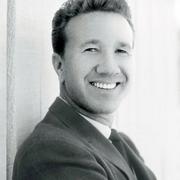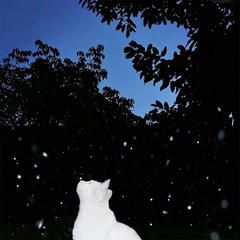Marty Robbins
原名马丁·戴维·罗宾逊(Martin Davaid Robinson),和他的孪生妹妹玛米一同出生于1925年9月26日,出生地是在美国亚利桑那州的菲尼克斯附近的格兰代尔;死于1982年12月8日,在田纳西州的纳什维尔。马蒂·罗宾斯的童年生活并不幸福,据说他的父亲是一位波兰移民,原先的名字是马辛斯基,他常常酗酒并且虐待家人,最后马蒂·罗宾斯的母亲艾玛带着7个孩子(其中有2个是来自于她的前一次婚姻)与之离婚,独自养活一家人。她在一家洗衣店找到了工作,全家就挤在格兰代尔的一间陋室中。少年时期,马蒂·罗宾斯曾和兄长在菲尼克斯郊外的农场上牧马,所以他没受过什么教育,也没有从格兰代尔中学毕业,在四十年代早期他成长为了一个惹人讨厌经常生事的少年。他后来离家出走,过起了流浪生活,直到1943年加入了美国海军,那年他还不满18岁。在军中服役3年,并且参加过太平洋战役。就是在军队中他学会了弹吉他、写歌曲并且演唱。从那时起,他就特别喜爱夏威夷音乐,在以后的艺术生涯中,他多次发行过夏威夷歌曲的唱片。1946年他退伍回到格兰代尔,在他开始为俱乐部表演之前,从事过许多职业,他的母亲曾经坚决反对他从事演唱,为此他不得不在演出时把名字改成“马蒂·罗宾斯”或者“杰克·罗宾斯”,以免让母亲发现。1950年前后,他开始在当地小有名气,并且长期在KTYL Mesa电台和菲尼克斯KPHO电台出现,还主持了一档名为“西部大篷车”(Western Caravan)的节目。1948年他和玛丽桑纳·鲍尔温结婚,这场婚姻一直持续他生命最后一刻。他们有一个儿子和一个女儿,儿子罗纳德后来也成了一名歌手,艺名是“罗尼·罗宾斯”和“小马蒂·罗宾斯”,不过他实在无法和他父亲相比。1952年,通过著名乡村艺人小杰米·迪更斯( Little Jimmy Dickens)的推荐,他与哥伦比亚唱片公司签约,并且正式使用了“马蒂·罗宾斯”这个艺名,1952年12月,他的一首歌“我继续孤独着”(I'll Go On Alone)成了他第一支登入美国乡村音乐榜的歌曲,这首歌是他自己创作的,主要是因为他妻子不赞成他进入音乐界,在榜上停留了18个星期,2次到达榜首的位置,可谓是一鸣惊人。1953年他搬去纳什维尔,加入了the Grand Ole Opry,并且得到了“泪珠先生”的绰号,后来他用这个名字为题目发行了一首歌。最初几年,马蒂·罗宾斯并没有太多的辉煌,1954年他录制了一首山地摇滚风格的歌“That's All Right”获得了一些好评,(当然,这首歌最受欢迎的版本是猫王艾尔维斯·普莱斯利的)这首歌和另外的一首“Maybellene”入选了“十大乡村金曲”。马蒂·罗宾斯一开始就意识到:只有在不同风格的音乐领域中都有所建树,他才能获得成功。于是在他的艺术生涯中,他演唱的歌曲从乡村到流行,从夏威夷民歌到福音歌曲,还包括一些拉美歌曲,有的是他自己用吉他亲自伴奏的。1956年他翻唱梅尔温·恩斯利(Melvin Endsley)的“Singing The Blues”又得到了乡村榜的第一名,并且这首歌在美国流行音乐榜也到达了17名。次年,他同样翻唱恩斯利的“Knee Deep In the Blues”到达乡村榜的第三名。1957到1958年间,马蒂·罗宾斯和纽约的雷·考尼夫(Ray Conniff)乐队合作录制了不少爱情歌曲,其中他自己创作的歌曲“一件白色运动衣”(A white sport coat)和另外2支歌“我生命中的故事”(the story of my life)、“爱的阶梯”(Stairway Of Love)都拿到了乡村榜的第一,“一件白色运动衣”还创下了百万销量。前2首歌曲还同时进入了美国流行榜和英国流行榜。五十年代末期,他开始专注于古老的西部歌曲(他的外祖父就曾当过得克萨斯的骑警),并且出演了3部西部片“老加利福尼亚的袭击者”、“马歇尔的警徽”和“野牛枪”。他还发行了一张名为“枪手传奇歌曲和小道歌谣” (Gunfighter Ballads And Trail Songs)的唱片,(不可思议的是,他在一天之内就录制完了这些歌曲。)1959年,他创作并演唱的同名电影主题曲“绞刑架”(The Hanging Tree),电影是由加里·库柏主演的,也取得了不错的销量,然后他的代表作“艾尔·帕索”(El Paso)同时在乡村和流行音乐榜上到达榜首,再次创下了百万销量,同时也是第一支乡村歌曲获得格莱美音乐奖的。这几支歌曲确立了马蒂·罗宾斯在叙事歌曲领域的地位,他的另外几支歌如“大手枪”(Big Iron)、“逃亡者”(Running Gun)受到了世界各地无数听众的喜爱。在六十年代,他有31首歌进入了乡村音乐榜,13首还同时进入了流行音乐榜。到达乡村音乐榜首的歌曲有“别担心”(Don't Worry)、“魔鬼女人”(Devil Woman,这首歌还同时拿到英国排行榜的第5名)、“鲁比·安”(Ruby Ann)、“黑夜中的丝带”(Ribbon of Darkness)、“卡门”(tonight Carmen)、“我独行”(I Walk Alone)。1964年,他支持巴里·古德沃特参加总统竞选,并写下了2支抨击共产主义和反战运动的歌曲“我做得对吗?”(Ain't I right)、“我亲爱的祖国土地”(My Own Native land),结果遭到哥伦比亚唱片公司的反对,他们害怕引起争议,所以不让他发行。于是,马蒂·罗宾斯的吉他手和伴唱鲍比·塞克斯(Bobby Sykes)化名“Johnny Freedom”(freedom的意思是:自由),在萨姆唱片公司发行了这2支歌,引起了很大轰动,许多人都认为那声音和玛蒂·罗宾斯的声音非常相像。后来马蒂·罗宾斯自己也在唱片“Pieces on your heart”中录制了这几支歌。1969年法兰基·兰恩(Frankie Lane)演唱了马蒂·罗宾斯创作的自传歌曲“You Give me a Mountain",并将它带入流行音乐榜,而强尼·布什(Johnny Bush)则发行了这首歌的乡村音乐版本,马蒂·罗宾斯自己居然从来没有单独发行过这支歌。那时他热衷于参加汽车拉力赛,参加过那什维尔汽车拉力赛,并且从多起事故中幸免于难。他还主持了一档名为“流浪者”的系列节目,在八部电影中扮演角色。同时他还写过一部西部小说《小人物》(Small man)。1970年,他动了一次心脏手术。在那年他自己创作的歌曲“我的女人,我的妻子”(My Woman,my wife)登上榜首,并且使他第二次获得了格莱美最佳乡村歌曲奖,乡村音乐协会评选他为过去十年最佳乡村艺人。72年他转投Decca唱片公司,然后在1975年重回哥伦比亚唱片公司,然后立刻发行了2支拿到乡村音乐榜首的歌曲“艾尔·帕索城”(El Paso City,艾尔·帕索的续歌)和“Among My Souvenirs)。整个七十年代,他有超过30首歌进入过乡村音乐排行榜。他的歌曲创作也到达了很高的水准,在1975年,他入选了纳什维尔歌曲作者国际名人堂(Nashville Songwriters' International Hall Of Fame ),1982年10月他入选了乡村音乐名人堂( Country Music Hall Of Fame)1981年他做了第二次心脏手术,他的“一些记忆永不会消逝”(Some Memories Just Won't Die)成了他1978年到1982年之间最畅销的歌曲。1982年12月1日,他开了个人最后一次演唱会,接着他第三次心脏病发作,12月8日他因病逝世,葬礼3天后在纳什维尔举行。接下来他的遗作“下等酒吧男人”(Honky Tonk Man,是伊斯特伍德的电影插曲)打入了排行榜,最终到达第10名。尽管在现实生活中马蒂·罗宾斯是个沉默寡言的内向的人,但是在舞台上,他又是非常能够打动所有的歌迷,展现出了卓越的能力,所有这一切,使他在各种音乐流派中都能取得不凡的成就。他有94首歌曾经进入过乡村音乐告示牌,在所有上榜的乡村艺人中排名第8,并且从1952年他第一次录制唱片到1982年他去世之间,至少每年都有一首歌打入排行榜,并且有31首歌同时还进入了流行音乐排行榜。马蒂·罗宾斯虽然在乡村、流行等诸多流派中都有建树,但是要说他最擅长表演的,那还是属于传奇叙事歌曲领域。他的嗓音圆润优美,丝毫没有某些乡村歌手所故意装出来的那种“乡土味”,在他的大多数歌曲中,班卓琴和曼陀林这两种传统乡村歌曲中所出现最多的乐器使用的次数并不是很多,但他的歌曲中所反映的内容,却又是最最纯粹的。他用他那甜美优雅的歌喉,把人们带回了美国西部的历史中去。那些古老、带有纯正西部风味的叙事歌谣,讲述了一个又一个故事,从往日司空见惯的枪战,到舍己救人的牛仔,无不展现着长久的艺术魅力。 by Hank DavisNo artist in the history of country music has had a more stylistically diverse career than Marty Robbins. Never content to remain just a country singer, Robbins performed successfully in a dazzling array of styles during more than 30 years in the business. To his credit, Robbins rarely followed trends but often took off in directions that stunned both his peers and fans. Plainly Robbins was not hemmed in by anyones definition of country music. Although his earliest recordings were unremarkable weepers, by the mid-50s Robbins was making forays into rock music, adding fiddles to the works of Chuck Berry and Little Richard. By the late 50s, Robbins had pop hits of his own with teen fare like A White Sport Coat (And a Pink Carnation). Almost simultaneously, he completed work on his Song of the Islands album. In 1959, Robbins stretched even further with the hit single El Paso, thus heralding a pattern of gunfighter ballads that lasted the balance of his career. Robbins also enjoyed bluesy hits like Dont Worry, which introduced a pop audience to fuzz-tone guitar in 1961. Barely a year later, Robbins scored a calypso hit with Devil Woman. Robbins also left a legacy of gospel music and a string of sentimental ballads, showing that he would croon with nary a touch of hillbilly twang.Born and raised in Glendale, AZ, Robbins (born Martin David Robertson, September 26, 1925; died December 8, 1982) was exposed to music at an early age. His mothers father was Texas Bob Heckle, a former medicine show man who told his grandson cowboy stories and tales of the traveling show. Robbins became enraptured by the cowboy tales and, once he became a teenager, worked on his older brothers ranch outside of Phoenix, concentrating more on his cowboy duties than his studies. Indeed, he never graduated from high school, and by his late teens, he started turning petty crimes while living as a hobo. In 1943, he joined the U.S. Navy to fight in World War II, and while he was in the service, he learned how to play guitar and developed a taste for Hawaiian music. Robbins left the Navy in 1947, returning to Glendale, where he began to sing in local clubs and radio stations. Often, he performed under the name Jack Robinson in an attempt to disguise his endeavors from his disapproving mother. Within three years, he had developed a strong reputation throughout Arizona and was appearing regularly on a Mesa radio station and had his own television show, Western Caravan, in Phoenix. By that time, he had settled on the stage name of Marty Robbins.Robbins landed a recording contract with Columbia in 1951 with the assistance of Little Jimmy Dickens, who had been a fan ever since appearing on Western Caravan. Early in 1952, Robbins released his first single, Love Me or Leave Me Alone. It wasnt a success and neither was its follow-up, Crying Cause I Love You, but Ill Go On Alone soared to number one in January 1953. Following its blockbuster success, Robbins signed a publishing deal with Acuff-Rose and joined the Grand Ole Opry. I Couldnt Keep From Crying kept him in the Top Ten in spring 1953, but his two 1954 singles — Pretty Words and Call Me Up (And Ill Come Calling on You) — stalled on the charts. A couple of rock & roll covers, Thats All Right and Maybellene, returned him to the country Top Ten in 1955, but it wasnt until Singing the Blues shot to number one in fall 1956 that Robbins career was truly launched. Staying at number one for a remarkable 13 weeks, Singing the Blues established Robbins as a star, but its progress on the pop charts was impeded by Guy Mitchells cover, which was released shortly after Robbins original and quickly leapfrogged to number one. The process repeated itself on Knee Deep in the Blues, which went to number three on the country charts but didnt even appear on the pop charts due to Mitchells hastily released cover. To head off such competition, Robbins decided to record with easy listening conductor Ray Conniff for his next singles. It was a crafty move and one that kept him commercially viable during the peak of rock & roll. The first of these collaborations, A White Sport Coat (And a Pink Carnation), became a huge hit, spending five weeks at the top of the country charts in spring 1957 and peaking at number two on the pop charts, giving him his long-awaited breakthrough record.After A White Sport Coat (And a Pink Carnation), Robbins was a regular fixation on both the pop and country charts until the mid-60s. The Burt Bacharach and Hal David composition The Story of My Life returned Robbins to the number one country slot in early 1957 (number 15 pop), while Just Married, Stairway of Love, and She Was Only Seventeen (He Was One Year More) kept him in teen-pop territory, as well as the upper reaches of the charts, throughout 1958. In addition to his pop records, Robbins recorded rockabilly singles and Hawaiian albums that earned their own audience. During that time, he began a couple of business ventures of his own, including a booking agency and a record label called Robbins. He also ventured into movies, appearing in the Westerns Raiders of Old California (1957) and Badge of Marshal Brennan (1958), where he played a Mexican named Felipe. The films not only demonstrated Robbins love for Western myths and legends, but they signalled the shift in musical direction he was about to take. Over the course of 1958 and 1959, he recorded a number of cowboy and western songs, and the first of these — The Hanging Tree, the theme to the Gary Cooper film of the same name — became a hit in spring 1959. However, the song just set the stage for Robbins signature song and biggest western hit, El Paso. Released in the summer, the single spent six months on the country charts, including seven weeks at number one, while hitting the top of the pop charts. A full album of western songs, Gunfighter Ballads and Trail Songs, became equally successful, reaching number six on the pop charts, and by the mid-60s, it had gone platinum.El Paso began a very successful decade for Robbins. Big Iron, another western song, followed its predecessor to the Top Ten of the country charts in 1960, but it wasnt until 1961 that he had another huge hit in the form of Dont Worry. Fueled by a fuzz-toned guitar (the first country record to feature such an effect), Dont Worry spent ten weeks at number one and crossed over to number three on the pop charts. The following year, Devil Woman became nearly as successful, spending eight weeks at number one; it was followed by another number one, Ruby Ann. Between Dont Worry and Devil Woman, he had a number of smaller hits, most notably the Top Ten Its Your World, and for the rest of the decade, his biggest hits alternated with more moderate successes. With his career sailing along, Robbins began exploring racecar driving in 1962, initially driving in dirt-track racing competitions before competing in the famous NASCAR race. However, car racing was just a hobby, and he continued to have hits in 1963, including the number one Begging to You. The following year, he starred in the film Ballad of a Gunfighter, which was based on songs from his classic album.Robbins chart success continued throughout 1964, before suddenly dipping after he took Gordon Lightfoots Ribbon of Darkness to number one in spring 1965. For the remainder of the year and much of the next, his singles failed to crack the Top Ten, and he concentrated on filming a television series called The Drifter, which was based on a character he had created. He also acted frequently, including the Nashville exploitation films Country Music Caravan, The Nashville Story, and Tennessee Jamboree and the stock-car drama Hell on Wheels. Though The Shoe Goes on the Other Foot Tonight reached number three in 1966, it wasnt until Tonight Carmen reached number one on the country charts in 1967 that his career picked up considerably. During the next two years, he regularly hit the Top Ten with country-pop songs like I Walk Alone and Its a Sin. Robbins suffered from a heart attack while on tour in August 1969, which led to a bypass operation in 1970. Despite his brush with death, he continued to record, tour, and act. Early in 1970, My Woman My Woman My Wife became his last major crossover hit, reaching number one on the country charts and 42 on the pop charts and eventually earning a Grammy award.Robbins left Columbia Records in 1972, spending the next three years at Decca/MCA. Though Walking Piece of Heaven, Love Me, and Twentieth Century Drifter all reached the Top Ten, most of his singles were unenthusiastically received. Nevertheless, he sustained his popularity through concerts and film appearances, including the Lee Marvin movie A Man and a Train and Guns of a Stranger. In March 1974, Robbins became the last performer to play at the Ryman Auditorium, the original location of the Grand Ole Opry; a week later, he was the first to play at the new Grand Ole Opry House. The honors and tributes to Robbins continued to roll out during the mid-70s, as he was inducted into Nashville Songwriters International Hall of Fame in 1975. That same year, he returned to Columbia Records, and over 1976 and 1977 he had his last sustained string of Top Ten hits, with El Paso City and Among My Souvenirs reaching number one. Following this two-year burst of success, Robbins settled into a series of minor hits for the next four years. In October 1982, he was inducted into the Country Music Hall of Fame. Two months later, he suffered his third major heart attack (his second arrived in early 1981), and although he had surgery, he died on December 8. In the wake of his death, his theme song to Clint Eastwoods movie Honky Tonk Man was released and climbed to number ten. Robbins left behind an immense legacy, including no less than 94 charting country hits and a body of recorded worked that proved how eclectic country music could be.


 The Hanging Tree - Marty Robbins
The Hanging Tree - Marty Robbins




























![[STATION] aespa《Dreams Come True》MV Teaser - aespa (에스파)](https://img2.kuwo.cn/wmvpic/324/79/54/2120387380.jpg?imageView2/1/w/195/h/130/format/jpg/q/60)





